The following collection of activity sheets will help your students learn about double negatives, offering short sentences to correct. Answer keys are provided, but in some cases answers will vary. Since some words have a prefix that means "not," students must be careful to say what they mean. For example, "His paper isn't illegible" can be correct if they are observing that it is easy to read, but is incorrect if they meant to use the word "legible." Fun Fact: While two negatives make a positive in English, in French (and other languages), two negatives can be used to make a more emphatic negative.
Print Double Negatives Worksheets
Click the buttons to print each worksheet and associated answer key.

Avoiding Negatives
When two negative words are used in the same sentence, it is called a double negative. The two words contradict each other, and can confuse the reader.

Corrections
Rewrite each sentence to correct the double negative. When you plant your rewrite make sure that the language flows well.

Feel Bad Words
It is possible to accidentally create a double negative in your sentence when using these words. Rewrite each sentence below to correct the double negative.
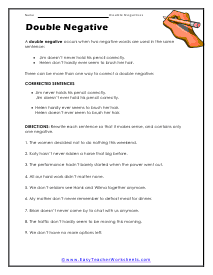


Avoiding Use
There are many situations where double negatives should be avoided, as only one negative word is needed to express a negative idea.

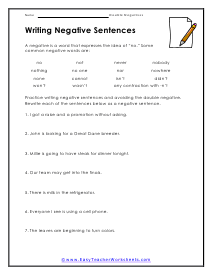
Writing Negative Sentences
Practice writing negative sentences and avoiding the double negative. Rewrite each of the sentences below as a negative sentence.
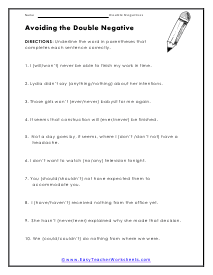
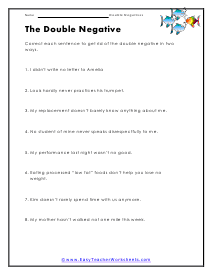

Lion of Sentence Writing
You will be given some sentences that can use some work. Eliminate or change words, as necessary.
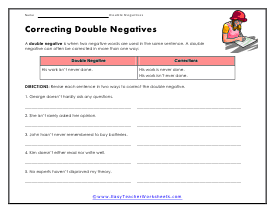

Rewrite Me
Choose the sentence that is written correctly. Rewrite each sentence to eliminate the double negative.
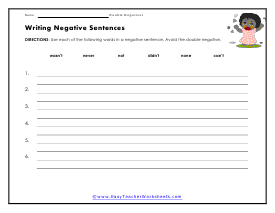
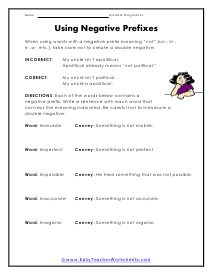
Using Negative Prefixes
When using words with a negative prefix meaning "not" (un-, in-, ir-, a-, etc.), take care not to create a double negative.
When to Use Double Negatives
Double negatives are common in conversations. While there are different schools of thought about it, most writing experts suggest not using it. Typically, people use more than one negative term to address multiple negatives in a sentence. If we look at it logically, we may find no practical sense in using it. If two negatives in a sentence always leave you thinking, you may not be the only one confused.
Most often, double negatives are used to emphasize the negativity of something. However, there are several cases where the meaning of the two negatives might be opposite to your interpretation. Although it is deemed incorrect in standard English, most common languages frequently use it.
Today, we will look into how you can use two negatives in a sentence. The objective of elaborating on these instances is to help you understand the meaning of using more than one negative term.
Ways to Use Them in Sentences
To Address Complex Meanings
Double negatives are often used to address complicated meanings. You may use them in situations where obvious "yes" or "no" does not help describe the message. There are many instances when we avoid being outspoken. If we do not want to offend someone with the direct use of negative terms, we may use two negatives to state the complicated (but slightly unclear) meaning.
For example, if you do not like to be in the same room with someone, you may express your relief upon their departure by saying, "It is not undelightful that Rose left." Here, you could describe the relief by saying that you are relieved or happy that Rose left. However, you chose a double negative to avoid the offensive tone.
Stressing the Negativity
Using two negatives in a sentence to stress the negativity of something is relatively common. You might have heard two negatives in a conversation against a harmful or unhealthy activity. In such instances, the direct negation may not seem as stressful as it should be. To emphasize the significance of the harm, people often use two negatives.
For example, you may use double negative sentences to stress the harms of consuming alcohol. To quote it in a sentence, you may express, "There is nothing less unhealthy than consuming alcohol." By associating two negatives with the use of alcohol, you stressed the fact that alcohol consumption is very harmful.
A Safety Backdoor
People often use two negatives to keep a safety backdoor open. Using double negative sentences in a conversation usually leaves the listener confused or thinking. If they associate an offense with the statement, you may be able to find your way out of it due to the unclarity. Such instances often occur in political gatherings.
For example, if you want to express your difference of opinion in a gathering where you may face sheer opposition, you can use terms like "not unlikely" instead of "likely." Two negatives address the same meaning that "likely" does. However, you may not be able to step back from your statement using the direct sense.
Maintaining the Rhythm
One of the common uses of two negatives is to maintain the rhythm of a sentence. It happens mostly when you want to create an impression with your words. If you opt for a more logical and less poetic approach to saying something, you may lose the charm of your sentence.
For example, you may use two negatives to maintain the rhythm of the sentence, "It was uncalled for but not unnecessary." Although you could say, “It was uncalled for but necessary,” its sound may not be as appealing.
Wrapping Up
Regardless of how fancy the use of double negatives in a sentence may be, standard English finds it incorrect. However, you may use two negatives in a row to express your thoughts in the instances mentioned above.



